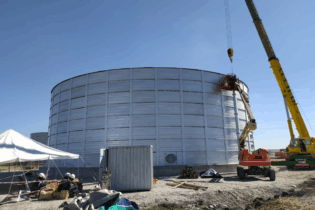For a continent where more than 300 million people lack access to safe drinking water, Africa is sitting on a lot of it.
The journal Environmental Research Letters recently published a set of maps of groundwater resources in Africa, the results of two years of research led by the British Geological Survey and financed by the British Department for International Development. The research showed that in Africa the volume of water naturally stored underground within the cracks and pores of rocks is much larger (possibly 20 times more) than the 8 000 cubic miles of water visible in lakes and rivers. This water holds enormous potential to help people and nations move out of poverty, produce more food and better adapt to climate change. But it also could lead to tensions between neighbouring countries. At least 45 transboundary aquifers have been identified in Africa so far, and competition sometimes leads to serious tensions. However, since groundwater moves very slowly (usually less than three feet per day), shared aquifers should be seen as vehicles for cooperation, rather than competition, and identifying and characterising the aquifers is the first step. Recognising this, in December 2011 the United Nations General Assembly called upon its members to begin working toward a common goal: the effective management of their shared groundwater resources. At the moment, the main constraint on supplying safe drinking water is lack of money. If there is sufficient investment in investigating groundwater, and water wells are carefully sited, it is usually possible to drill a well that can provide enough safe water for communities at a reasonable cost. Groundwater responds slowly to droughts and floods and, as a result, is much more resilient to climate variability than water supplies drawn from rivers or ponds. Therefore, serious and sustained investment in water wells and pumps will help provide a reliable and secure water supply to a significant number of those without safe drinking water.Money on its own, however, will not solve drinking-water problems. About 30% of Africa’s water wells are no longer operational, so donors like the World Bank, the Gates Foundation and the United States Agency for International Development need to get serious about maintenance and sustainability of services. New water supplies tend to gravitate to the better off, so investment in new services should be aimed at more remote areas where many of the poorest live; and with increased groundwater use comes the need for more qualified and experienced people to develop and manage the resource.
A major concern is that people may use the groundwater for whatever seems like a good idea at the time in a way that is unsustainable. There is much discussion about food insecurity in Africa, and at first glance irrigation based on groundwater seems like the perfect answer. However, it is not that simple. Our maps show that away from the large aquifers under the Sahara there are not many places where you can drill a water well and expect to pump out enough water to sustain center pivot irrigators like those in Nebraska. A potential compromise may be to encourage small-scale irrigation using lower yielding water wells. This approach will also require significant investment in expertise within Africa in groundwater development and governance and in reducing the costs of drilling and pumps. And what about all that water under the Sahara? As inviting as it is, unfortunately this fossil water is not that easy to get at, requiring expensive, deep water wells and large pipelines to move the water to where people need it. Libya is the one country to have invested heavily in using Saharan groundwater, having spent some $20 billion to supply water to the coastal cities and for irrigation. We should not be distracted by the large aquifers below the Sahara and dreams of cross-continental pipelines. The priority must be to serve those who still have to take unsafe drinking water from ponds and holes in dry riverbeds — and to do this sensibly and sustainably. We should get on with the job of getting drilling costs down and construction standards up and supporting and developing groundwater professionals in Africa. Then we can concentrate on helping communities, small towns and whole nations to sustainably develop and protect the groundwater under their feet. Source: New York Times






